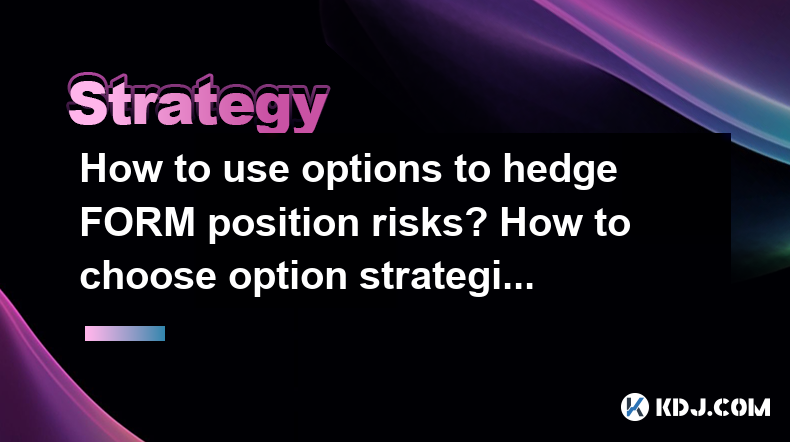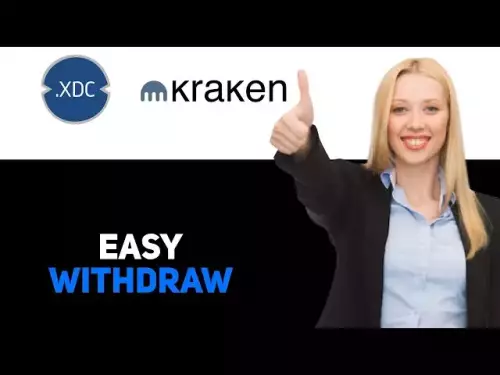-
 bitcoin
bitcoin $114684.631706 USD
-0.87% -
 ethereum
ethereum $4228.677447 USD
1.58% -
 bnb
bnb $1294.880693 USD
-1.16% -
 tether
tether $1.000819 USD
-0.02% -
 xrp
xrp $2.605138 USD
2.79% -
 solana
solana $209.908690 USD
5.89% -
 usd-coin
usd-coin $0.999903 USD
-0.03% -
 dogecoin
dogecoin $0.213423 USD
2.93% -
 tron
tron $0.322721 USD
-0.10% -
 cardano
cardano $0.727247 USD
3.66% -
 hyperliquid
hyperliquid $42.339456 USD
6.05% -
 chainlink
chainlink $19.910811 USD
5.16% -
 ethena-usde
ethena-usde $1.000557 USD
0.00% -
 stellar
stellar $0.349734 USD
2.69% -
 bitcoin-cash
bitcoin-cash $543.848687 USD
-0.21%
How to use options to hedge FORM position risks? How to choose option strategies?
Hedging FORM with options like protective puts, covered calls, or collars can manage risk effectively, allowing potential gains while limiting losses.
May 04, 2025 at 07:21 pm

Hedging a position in a cryptocurrency like FORM using options can be an effective strategy to manage risk. Options provide the right, but not the obligation, to buy or sell an asset at a predetermined price within a specific time frame. This article will guide you through the process of using options to hedge your FORM position and choosing the right option strategies.
Understanding Options and Hedging
Options are financial derivatives that give the buyer the right to buy or sell an underlying asset at a specified price on or before a certain date. There are two types of options: calls and puts. A call option gives the holder the right to buy the asset, while a put option gives the holder the right to sell the asset.
Hedging is a strategy used to reduce or offset the risk of adverse price movements in an asset. By using options, you can hedge your FORM position to protect against potential losses while still maintaining the possibility of benefiting from favorable price movements.
Choosing the Right Option Strategy
Selecting the appropriate option strategy depends on your market outlook and risk tolerance. Here are some common strategies you can use to hedge your FORM position:
Protective Put
A protective put involves buying a put option for the same number of FORM tokens you own. This strategy is used when you are bullish on FORM but want to protect against a potential decline in its price.
- Step 1: Determine the number of FORM tokens you want to hedge.
- Step 2: Choose an expiration date for the put option that aligns with your holding period.
- Step 3: Select a strike price that you believe will provide adequate protection. A lower strike price offers more protection but at a higher cost.
- Step 4: Purchase the put option. If the price of FORM falls below the strike price, you can exercise the option to sell your FORM at the strike price, limiting your losses.
Covered Call
A covered call involves selling a call option on FORM tokens you already own. This strategy is used when you are neutral to slightly bullish on FORM and want to generate additional income from your position.
- Step 1: Determine the number of FORM tokens you want to use for the covered call.
- Step 2: Choose an expiration date for the call option that aligns with your holding period.
- Step 3: Select a strike price that you believe FORM is unlikely to reach before expiration. A higher strike price offers more potential profit but less protection.
- Step 4: Sell the call option. If the price of FORM stays below the strike price, you keep the premium received from selling the option. If the price rises above the strike price, you may have to sell your FORM at the strike price but still keep the premium.
Collar
A collar involves buying a put option and selling a call option simultaneously. This strategy is used when you want to limit both the upside and downside potential of your FORM position.
- Step 1: Determine the number of FORM tokens you want to hedge.
- Step 2: Choose an expiration date for both the put and call options that aligns with your holding period.
- Step 3: Select a put option strike price that provides adequate downside protection.
- Step 4: Select a call option strike price that you are willing to sell your FORM at if the price rises.
- Step 5: Purchase the put option and sell the call option. The premium received from selling the call can help offset the cost of the put.
Implementing the Hedge
Once you have chosen your option strategy, you need to implement the hedge. Here are the steps to follow:
- Step 1: Open an account with a cryptocurrency options exchange that supports FORM options, such as Deribit or LedgerX.
- Step 2: Fund your account with the necessary cryptocurrency or fiat currency to purchase the options.
- Step 3: Navigate to the options trading section of the exchange and select the FORM options.
- Step 4: Choose the expiration date and strike price for your chosen strategy.
- Step 5: Execute the trade by buying or selling the options as per your strategy.
Monitoring and Adjusting the Hedge
After implementing your hedge, it is crucial to monitor the position and make adjustments as needed. Here are some tips for managing your hedge:
- Regularly check the price of FORM and the value of your options. This will help you understand the effectiveness of your hedge.
- Adjust the hedge if necessary. If the price of FORM moves significantly, you may need to buy or sell additional options to maintain the desired level of protection.
- Consider closing the hedge early if it is no longer needed. If the price of FORM moves in a favorable direction, you may want to close the hedge to avoid further costs.
Calculating the Cost of Hedging
The cost of hedging your FORM position with options includes the premium paid for buying options and the potential opportunity cost of selling options. Here is how to calculate the cost:
- For a protective put: The cost is the premium paid for the put option.
- For a covered call: The cost is the potential opportunity cost of selling your FORM at the strike price if the call option is exercised.
- For a collar: The cost is the net premium paid for the put option minus the premium received from selling the call option.
Frequently Asked Questions
Q1: Can I hedge my FORM position with options on other cryptocurrencies?A1: No, you cannot hedge your FORM position with options on other cryptocurrencies. Options are specific to the underlying asset, so you need to use FORM options to hedge a FORM position.
Q2: What happens if I don't exercise my options before they expire?A2: If you do not exercise your options before they expire, they will become worthless, and you will lose the premium paid for the options.
Q3: Can I use options to hedge a short position in FORM?A3: Yes, you can use options to hedge a short position in FORM. For example, you can buy a call option to hedge against a potential increase in the price of FORM.
Q4: Are there any tax implications of using options to hedge my FORM position?A4: Yes, there may be tax implications depending on your jurisdiction. It is advisable to consult with a tax professional to understand the specific tax treatment of options trading in your area.
Disclaimer:info@kdj.com
The information provided is not trading advice. kdj.com does not assume any responsibility for any investments made based on the information provided in this article. Cryptocurrencies are highly volatile and it is highly recommended that you invest with caution after thorough research!
If you believe that the content used on this website infringes your copyright, please contact us immediately (info@kdj.com) and we will delete it promptly.
- XRP Price Prediction: Weekend Rollercoaster or Rally?
- 2025-10-12 08:45:16
- Bittensor (TAO): Super Bullish Signals Point to Potential 2x Rally
- 2025-10-11 10:25:12
- Silver Price Correction: Navigating the Dip & Identifying Key SEO Keywords
- 2025-10-11 10:25:12
- Decoding Crypto Trends: Bittensor's Bull Run, Cardano's Dip, and LivLive's Presale Buzz in 'Uptober 2025'
- 2025-10-12 08:45:16
- MoonBull: The Crypto Meme Coin Promising 1000x Gains?
- 2025-10-11 10:30:01
- Crypto Payroll Revolution: Stablecoins, Altcoins, and the Future of Salary Payments
- 2025-10-11 10:30:01
Related knowledge

Practical parameter settings for a Bitcoin multi-timeframe moving average system
Sep 18,2025 at 10:54pm
Optimizing Timeframe Combinations for Bitcoin Trading1. Selecting appropriate timeframes is crucial when building a multi-timeframe moving average sys...

How can I filter out false breakouts in Dogecoin high-frequency trading?
Sep 22,2025 at 01:00am
Understanding False Breakouts in Dogecoin Trading1. A false breakout occurs when Dogecoin's price appears to move beyond a defined support or resistan...

Techniques for identifying tops and bottoms in the Bitcoin on-chain NVT model
Sep 20,2025 at 07:54pm
Understanding the NVT Model in Bitcoin Analysis1. The Network Value to Transactions (NVT) ratio is often described as the 'P/E ratio' of the cryptocur...

What does the surge in open interest in Bitcoincoin futures mean?
Sep 20,2025 at 11:18pm
Understanding the Surge in Dogecoin Futures Open Interest1. A surge in open interest within Dogecoin futures indicates a growing number of active cont...

How can I use the Ethereum USDT premium to gauge market sentiment?
Sep 18,2025 at 11:55pm
Understanding the Ethereum USDT Premium1. The Ethereum USDT premium refers to the price difference between USDT (Tether) traded on Ethereum-based plat...

What should I do if Ethereum staking yields decline?
Sep 20,2025 at 06:18am
Understanding the Causes Behind Declining Ethereum Staking Yields1. The Ethereum network transitioned to a proof-of-stake consensus mechanism with the...

Practical parameter settings for a Bitcoin multi-timeframe moving average system
Sep 18,2025 at 10:54pm
Optimizing Timeframe Combinations for Bitcoin Trading1. Selecting appropriate timeframes is crucial when building a multi-timeframe moving average sys...

How can I filter out false breakouts in Dogecoin high-frequency trading?
Sep 22,2025 at 01:00am
Understanding False Breakouts in Dogecoin Trading1. A false breakout occurs when Dogecoin's price appears to move beyond a defined support or resistan...

Techniques for identifying tops and bottoms in the Bitcoin on-chain NVT model
Sep 20,2025 at 07:54pm
Understanding the NVT Model in Bitcoin Analysis1. The Network Value to Transactions (NVT) ratio is often described as the 'P/E ratio' of the cryptocur...

What does the surge in open interest in Bitcoincoin futures mean?
Sep 20,2025 at 11:18pm
Understanding the Surge in Dogecoin Futures Open Interest1. A surge in open interest within Dogecoin futures indicates a growing number of active cont...

How can I use the Ethereum USDT premium to gauge market sentiment?
Sep 18,2025 at 11:55pm
Understanding the Ethereum USDT Premium1. The Ethereum USDT premium refers to the price difference between USDT (Tether) traded on Ethereum-based plat...

What should I do if Ethereum staking yields decline?
Sep 20,2025 at 06:18am
Understanding the Causes Behind Declining Ethereum Staking Yields1. The Ethereum network transitioned to a proof-of-stake consensus mechanism with the...
See all articles

























![[4K 60fps] Prisma by novichokk (1 Coin) [4K 60fps] Prisma by novichokk (1 Coin)](/uploads/2025/10/14/cryptocurrencies-news/videos/k-fps-prisma-novichokk-coin/68ee49804ba00_image_500_375.webp)
















































